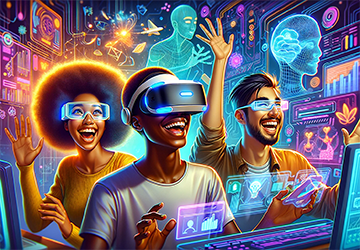Empowering Education Through Technology Bridging the Digital Divide
In the 21st century, integrating technology into education has become indispensable for fostering equity and accessibility. The digital divide, an insurmountable impediment to educational parity, must be facilitated through avant-garde tech solutions. This treatise elucidates how tech solutions for education equality, overcoming the digital divide, and technology in global education are metamorphosing the pedagogical landscape.
In the 21st century, integrating technology into education has become indispensable for fostering equity and accessibility. The digital divide, an insurmountable impediment to educational parity, must be facilitated through avant-garde tech solutions. This treatise elucidates how tech solutions for education equality, overcoming the digital divide, and technology in global education are metamorphosing the pedagogical landscape.

Tech Solutions for Education Equality
Enhancing Accessibility
Tech solutions for education equality endeavour to make educational resources accessible to all learners, irrespective of their geographical locus or socio-economic stratum. Paramount strategies include:
- E-learning platforms that proffer courses and resources online.
- Mobile learning applications dispensing educational content on smartphones.
- Open educational resources (OER) offering unfettered access to didactic materials.
Supporting Inclusive Education
Inclusive education ensures that students with disabilities can learn alongside their peers. Tech solutions for education equality are pivotal at this moment:
- Proffering assistive technologies such as screen readers and speech-to-text software.
- Developing adaptive learning systems that customize content to individual preferences.
- Implementing virtual reality (VR) for immersive learning experiences.
Adaptive Learning Technologies
Tech solutions for education equality are evolving rapidly with the advent of adaptive learning technologies. These systems recalibrate educational content predicated on real-time student performance analysis. Noteworthy innovations encompass:
- Intelligent tutoring systems that provide bespoke feedback and guidance.
- Dynamic assessment tools that modulate questions based on student responses.
- AI-driven content recommendations tailored to individual cognitive styles.
Cloud-Based Education Platforms
Cloud technology is revolutionizing tech solutions for education equality by making high-calibre resources accessible to anyone with an internet connection. Salient developments include:
- Virtual classrooms that facilitate synchronous interaction between educators and learners.
- Cloud storage solutions that provide securitized access to educational materials.
- Collaborative tools such as shared documents and project management platforms.
Overcoming the Digital Divide
Infrastructure Development
Overcoming the digital divide necessitates substantial investment in infrastructure, particularly in underserved regions. Efforts to redress this include:
- Expanding broadband access to rural and remote territories.
- Establishing community internet centres where students can access digital resources.
- Collaborating with tech enterprises to provide affordable devices to students.
Digital Literacy Programs
Endowing students and educators with digital competencies is essential for overcoming the digital divide. Key initiatives include:
- Professional development programs for instructors to integrate technology into their pedagogical praxis.
- Student workshops focusing on fundamental and advanced digital acumen.
- Parental engagement sessions to support digital learning at home.
Community-Driven Initiatives
- Community-driven initiatives are imperative to overcome the digital divide efficiently. These grassroots efforts ensure that technology is seamlessly integrated into local educational paradigms. Strategies include:
- Digital literacy training programs orchestrated by local educators and volunteers.
- Technology lending libraries that provide temporary access to devices and the internet.
- Public-private partnerships to finance and sustain digital inclusion projects.
Policy Advocacy and Implementation
Governmental policies are quintessential in overcoming the digital divide. Efficacious advocacy and implementation can significantly ameliorate tech access and education quality. Indispensable policies include:
- Universal service funds to subsidize internet access in underprivileged areas.
- Educational technology standards to ensure homogenous quality across regions.
- Incentives for tech companies to invest in educational infrastructure.
Technology in Global Education
Bridging Cultural Gaps
Technology in global education fosters cross-cultural comprehension and collaboration. Key approaches include:
- Global virtual classrooms connecting students from disparate nations.
- Online exchange programs facilitating cultural exchanges and language acquisition.
- Collaborative projects using digital platforms to address global challenges.
Enhancing Learning Outcomes
Technology in global education enhances learning outcomes by providing variegated and engaging learning experiences. Methods include:
- Gamification to render learning interactive and enjoyable.
- Artificial intelligence (AI) for personalized learning trajectories.
- Data analytics to monitor and enhance student performance.
Blockchain for Credential Verification
Technology in global education is leveraging blockchain to ascertain the veracity of educational credentials. This innovation aids in:
- Preventing diploma fraud through immutable digital records.
- Streamlining the verification process for employers and educational institutions.
- Facilitating global recognition of qualifications.
Immersive Learning Environments
Technology in global education has burgeoned to encompass immersive learning environments, augmenting engagement and comprehension. Exemplars include:
- Augmented reality (AR) experiences for interactive historical site visits.

- Mixed reality (MR) laboratories for intricate scientific experiments.
Case Studies
India: Digital India Initiative
The Digital India initiative aims at overcoming the digital divide by promulgating digital literacy and connectivity. Key accomplishments include:
- Establishing Wi-Fi hotspots in rural locales.
- Launching e-learning platforms such as SWAYAM.
- Providing subsidized tablets to students.
Kenya: BRCK Education
BRCK Education is an avant-garde effort in tech solutions for education equality in Africa. Its impact includes:
- Kio Kits with pre-loaded educational content are being deployed in remote schools.
- Creating digital classrooms equipped with requisite tech infrastructure.
- Training educators in digital pedagogies.
Finland: EdTech Innovations
Finland, renowned for its exemplary education system, leverages technology in global education to maintain its standards. Key initiatives include:
- Implementing AI-driven personalized learning tools.
- Utilizing VR and AR for interactive science lessons.
- Encouraging coding and robotics from an early age.
Challenges and Future Directions
Addressing Inequality
While significant progress has been made, challenges remain in ensuring that tech solutions for education equality reach all learners. Addressing these requires:
- Policy interventions to support equitable tech access.
- Sustainable funding models for enduring initiatives.
- Community engagement to tailor solutions to local contingencies.
Ensuring Data Privacy
As technology in global education expands, safeguarding student data becomes paramount. Key considerations include:
- Implementing robust cybersecurity measures.
- Developing explicit data privacy policies.
- Educating students and parents about online safety.
Bridging the Rural-Urban Divide
A formidable challenge in ensuring tech solutions for education equality is the rural-urban chasm. Potential solutions include:
- Satellite internet services to furnish connectivity in remote areas.
- Mobile tech labs to deliver hands-on learning experiences to rural students.
- Rural-urban teacher exchange programs to disseminate best practices and resources.
Addressing Technological Obsolescence
The rapid velocity of technological progression poses a challenge for overcoming the digital divide. Strategies to address obsolescence include:
- Regular updates and upgrades to educational technology infrastructure.
- Long-term partnerships with tech companies for sustained support.
- Recycling and refurbishing programs for outdated devices.
Case Studies of Successful Implementations
Brazil: Digital Education Programs
Brazil's endeavours to overcome the digital divide through comprehensive digital education programs have been laudable. Notable initiatives include:
- ProInfo, which furnishes computer labs and internet access to public schools.
- Mobile learning units that traverse remote areas offer digital literacy training.
- Teacher training workshops to enhance digital pedagogical skills.
Conclusion
Empowering education through technology is essential for bridging the digital divide and fostering global educational equality. By leveraging tech solutions for education equality, overcoming the digital divide, and advancing technology in international education, we can create a more inclusive and equitable future for all learners. Continued investment, innovation, and collaboration are pivotal to realizing this vision.